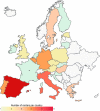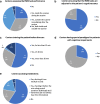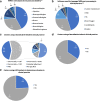Clinical practice of language fMRI in epilepsy centers: a European survey and conclusions by the ESNR Epilepsy Working Group
- PMID: 32170372
- PMCID: PMC7186249
- DOI: 10.1007/s00234-020-02397-w
Clinical practice of language fMRI in epilepsy centers: a European survey and conclusions by the ESNR Epilepsy Working Group
Abstract
Purpose: To assess current clinical practices throughout Europe with respect to acquisition, implementation, evaluation, and interpretation of language functional MRI (fMRI) in epilepsy patients.
Methods: An online survey was emailed to all European Society of Neuroradiology members (n = 1662), known associates (n = 6400), and 64 members of European Epilepsy network. The questionnaire featured 40 individual items on demographic data, clinical practice and indications, fMRI paradigms, radiological workflow, data post-processing protocol, and reporting.
Results: A total of 49 non-duplicate entries from European centers were received from 20 countries. Of these, 73.5% were board-certified neuroradiologists and 69.4% had an in-house epilepsy surgery program. Seventy-one percent of centers performed fewer than five scans per month for epilepsy. The most frequently used paradigms were phonemic verbal fluency (47.7%) and auditory comprehension (55.6%), but variants of 13 paradigms were described. Most centers assessed the fMRI task performance (75.5%), ensured cognitive-task adjustment (77.6%), trained the patient before scanning (85.7%), and assessed handedness (77.6%), but only 28.6% had special paradigms for patients with cognitive impairments. fMRI was post-processed mainly by neuroradiologists (42.1%), using open-source software (55.0%). Reporting was done primarily by neuroradiologists (74.2%). Interpretation was done mainly by visual inspection (65.3%). Most specialists (81.6%) were able to determine the hemisphere dominance for language in more than 75% of exams, attributing failure to the patient not performing the task correctly.
Conclusion: This survey shows that language fMRI is firmly embedded in the preoperative management of epilepsy patients. The wide variety of paradigms and the use of non-CE-marked software underline the need for establishing reference standards.
Keywords: Epilepsy; Europe; Language; Survey; fMRI.
Conflict of interest statement
The authors declare that they have no conflict of interest.
Figures






Similar articles
-
Dementia imaging in clinical practice: a European-wide survey of 193 centres and conclusions by the ESNR working group.Neuroradiology. 2019 Jun;61(6):633-642. doi: 10.1007/s00234-019-02188-y. Epub 2019 Mar 9. Neuroradiology. 2019. PMID: 30852630 Free PMC article.
-
Neuromuscular imaging in clinical practice: an ESNR survey of 30 centers.Neuroradiology. 2024 Feb;66(2):179-186. doi: 10.1007/s00234-023-03255-1. Epub 2023 Dec 19. Neuroradiology. 2024. PMID: 38110540
-
Presurgical language fMRI: Technical practices in epilepsy surgical planning.Hum Brain Mapp. 2018 Oct;39(10):4032-4042. doi: 10.1002/hbm.24229. Epub 2018 Jul 1. Hum Brain Mapp. 2018. PMID: 29962111 Free PMC article.
-
Functional magnetic resonance imaging for assessment of language and memory in clinical practice.Curr Opin Neurol. 2005 Apr;18(2):161-6. doi: 10.1097/01.wco.0000162858.60144.ca. Curr Opin Neurol. 2005. PMID: 15791147 Review.
-
What are we really predicting with fMRI in epilepsy surgery?Epilepsy Behav. 2023 Aug;145:109298. doi: 10.1016/j.yebeh.2023.109298. Epub 2023 Jun 23. Epilepsy Behav. 2023. PMID: 37356225 Review.
Cited by
-
Roles of fMRI and Wada tests in the presurgical evaluation of language functions in temporal lobe epilepsy.Front Neurol. 2022 Sep 30;13:884730. doi: 10.3389/fneur.2022.884730. eCollection 2022. Front Neurol. 2022. PMID: 36247757 Free PMC article.
-
Task-based functional magnetic resonance imaging prediction of postsurgical cognitive outcomes in temporal lobe epilepsy: A systematic review, meta-analysis, and new data.Epilepsia. 2023 Feb;64(2):266-283. doi: 10.1111/epi.17475. Epub 2022 Dec 29. Epilepsia. 2023. PMID: 36522799 Free PMC article.
-
Overt speech critically changes lateralization index and did not allow determination of hemispheric dominance for language: an fMRI study.BMC Neurosci. 2021 Dec 1;22(1):74. doi: 10.1186/s12868-021-00671-y. BMC Neurosci. 2021. PMID: 34852787 Free PMC article.
-
Assessing Language Lateralization through Gray Matter Volume: Implications for Preoperative Planning in Brain Tumor Surgery.Brain Sci. 2024 Sep 24;14(10):954. doi: 10.3390/brainsci14100954. Brain Sci. 2024. PMID: 39451969 Free PMC article.
-
Task-Based and Resting-State Functional MRI in Observing Eloquent Cerebral Areas Personalized for Epilepsy and Surgical Oncology Patients: A Review of the Current Evidence.J Pers Med. 2023 Feb 19;13(2):370. doi: 10.3390/jpm13020370. J Pers Med. 2023. PMID: 36836604 Free PMC article. Review.
References
-
- Kwan P, Arzimanoglou A, Berg AT, Brodie MJ, Allen Hauser W, Mathern G, Moshé SL, Perucca E, Wiebe S, French J. Definition of drug resistant epilepsy: consensus proposal by the ad hoc Task Force of the ILAE Commission on Therapeutic Strategies. Epilepsia. 2010;51:1069–1077. doi: 10.1111/j.1528-1167.2009.02397.x. - DOI - PubMed

